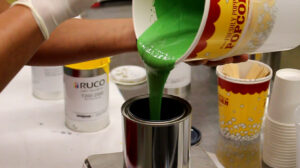by Micah Swett, sales manager, Diversified Printing Techniques
Ink selection for pad printing is critical not only to the performance of the ink on the product but also to the behavior of the ink during the printing process. Often, ink can be generalized while it should be considered specifically for each application. The first aspect to consider is the material which generally breaks down to plastic, metal, wood or other organic materials. Actually, it must be broken down further than this. There are many different types of plastic, and many plastics need to be considered very specifically. For instance, some inks can crack or harm sensitive plastics while some plastics have fillers like glass, which require specialty inks for proper adhesion. With metal surfaces, it is important to consider if the material has been treated, painted or coated with something which might affect the ink adhesion.
Application and testing

The next factor to consider is the application of the product. Will the product be used indoors or outdoors? What exposure will the product have to cleaners or other chemicals? Is the product used in a medical application or a toy? Does it need to be dishwasher safe? Similarly, it is important to consider if there are regulatory compliances that the product needs to meet, like Class VI, Sony, Reach, etc.
Much of the testing on the performance of the ink can be accomplished with simple procedures. Even though a fingernail is not a technical tool, it has become a benchmark for scratching ink to check for adhesion. A common technical test is the crosshatch test with a tape pull. If more comprehensive tests are necessary for such things as abrasion, pencil hardness and chemical resistance, there are specific labs and equipment available to accomplish this. There also can be UV, heat and humidity exposure tests that can be performed for specific applications.
Ink colors and additives

The color of the ink is another important factor to consider when selecting the ink for the specific pad printing application. Most inks are available in standard colors, and there are color-matching capabilities to match to Pantone or other color standards. Many ink manufacturers offer simple color-matching systems that allow color matching in-house by the pad printer. Some inks have the capability of printing 4-color process; however, this is not widely available and needs special consideration. There also are highly opaque inks available as well, which allow for brighter colors on darker substrates.
Additives that are added to the pad printing inks are another area of consideration. Typically with inks, there are thinners and hardeners/adhesion modifiers. Most solvent-based inks require a thinner, while many UV-based inks applications do not require thinners, although they still are required for most pad printing applications. Depending on the printing process, the amount of thinner can vary greatly and be technically specified. The thinner keeps the ink wet during the printing process, and the thinner can be adjusted for differing press speeds for the specific printing application. In pad printing, the solvent helps to prepare the ink with a certain tackiness, while in the cliché it is used “again” when the ink is on the pad to prepare it best for transfer to the product.
When thinning the ink, it is important to consider the viscosity. Commonly, the thinner should be added to the ink by weight; however, this step often is overlooked, and operators will just “eye” how much to add. This can cause inconsistent printing results and waste production time troubleshooting the ink. It is important to understand that with solvent inks, the viscosity of the ink begins to change once the factory seal is broken on the can. If the viscosity of the ink is measured once the thinner is added, then a benchmark can be set, and a repeatable ink mixture can be used every time ink is mixed. Even if the ink is in a contained environment (like a closed ink cup in pad printing), the viscosity will change during production. When this becomes a problem for production, the printing process has to stop so additional thinner can be added to the ink. There are solutions with devices to thin the ink during the pad printing process so the machine does not have to be paused and production can continue.
There are one-component and two-component inks on the market today. Some inks can behave as a one- or two-component ink, depending on the application. The hardener or adhesion modifier can be added to the ink to help the ink to perform better for scratching, rubbing or chemical resistance. The hardener typically reduces the pot life of the ink and can make the ink more challenging to print with, especially over time.
There are other additives available as well that can help the ink produce better results. Some common additives are anti-static paste and bubble breaker. The bubble breaker commonly is used with inks that have aggressive hardeners as the chemical reaction in the ink can cause an orange peel effect when it is applied to the plastic part. The bubble breaker helps to smooth the ink film out, improving the visual nature of the finished product. The anti-static paste is used when the ink chemistry creates a string or spiderweb effect outside the image area. This paste helps to keep the ink in the print area and cleans up the overprint.

When it is time to mix the ink with the thinner and the other components, it is critical to remember some simple steps.
- First, mix the ink in the can. The pigments often sink to the bottom of the can and other components of the ink may separate. Mixing the ink in the existing can provides a format that the manufacturer intended.
- Always use a scale. Chemists have worked very hard to develop inks for specific applications and there are reasons for the amounts of thinner, hardener and additives that are recommended. Getting the recipe right provides a baseline that always can be referenced and improve the production experience. In pad printing, it is recommended that a scale that reads two numbers past the decimal be used.
- It also is recommended to mix the hardener with the ink and then add any other additives before thinning the ink. Please note that some inks will bubble after mixing.
- It is best to let the ink rest for a few minutes before beginning the pad printing process.
This admittingly is a broad and 101 level view of inks, ink selection and ink preparation. There are great experienced technicians who can help take you further into the ink selection process. Testing any product with several inks is the best approach in finding the correct ink not only for the specific product but also for proper set-up of the machine.
Micah Swett is the sales manager for Diversified Printing Techniques. Diversified is the exclusive agent for the US for Kent International, manufacturer of pad printing equipment and robotics for pad printing automation. For more information, call 704.583.9433 or visit www.diverprint.com.


